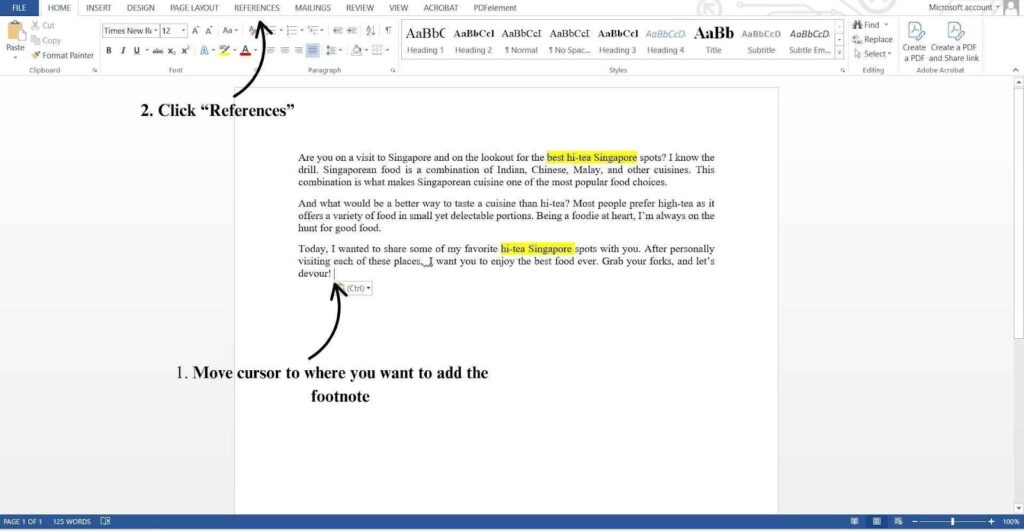Did you know that 78% of academic papers and research articles use footnotes or endnotes for citation purposes? That’s a huge chunk of work that wouldn’t be nearly as credible without them! And yet, despite their importance, how to write footnotes remains one of the most misunderstood aspects of writing.
There’s a tiny number at the bottom of the page called footnotes. Don’t know what a footnote is, why or where it is used? Don’t worry! We’ll tell you all this in today’s article so read till the end to know how to write footnotes and format your writing the right way!

What Are Footnotes And Why Are They Important?
Footnotes are small notes or citations placed at the bottom of a page in your document. They offer additional information, clarification, or references without interrupting the flow of your main content. You’ll usually see footnotes indicated by a small number or symbol in the text (like this¹), which matches a corresponding note at the bottom of the page.
Why Are Footnotes Important?
Here are a few reasons why you should learn how to write footnotes:
- Give Your Work Credibility: By using footnotes to cite your sources, you’re giving credit to the original authors and showing that your work is well-researched.
- Keep Things Clean and Organized: Instead of cluttering up your writing with long references or extra explanations, footnotes let you add helpful info without disturbing the flow of your text.
- Add Extra Value: Footnotes give you the chance to share additional insights, facts, or even translations without losing focus on your main point.
- Make Your Writing Easier to Read: With footnotes, your reader can enjoy a smoother reading experience while still being able to access important references or details at the bottom of the page.
- Boost Your Academic Credibility: In the world of academic writing, using footnotes properly ensures you meet citation standards and avoid plagiarism. Hence, they are your key to maintaining scholarly integrity.
Different Formats Of Footnotes
When it comes to how to write footnotes, it’s not a one-size-fits-all scenario. There are plenty of options depending on your style, and each citation style has its own flavour. Writing research for a psychology paper, writing a literature review, or crafting an essay on historical events? Footnotes are there to back you up. So, let’s explore the key formats, shall we?
APA Style Footnotes
APA style is like that reliable friend who’s always on time and likes to keep things simple. It’s the go-to format for psychology, sociology, and education papers. In APA, footnotes help with citations or provide some quick extra context, but they don’t take the spotlight. There are two further types of APA-style footnotes:
- Citation Footnotes:
When you’re giving credit to your sources, APA footnotes are concise, almost like a polite nod to the original author. They typically include the author’s name, the year of publication, and the title of the book.
Example:
Smith, J. (2020). The Art of Footnotes. Fiction Press.
- Content Footnotes:
These are for when you want to add a little extra spice without overshadowing your main dish. Think of them as small detours that give the reader extra context, like maybe explaining a complex term or referencing another paper.
Example:
- The term “footnotes” refers to additional comments or citations found at the bottom of a page, often used in academic texts.
APA keeps it short and sweet, just like a good footnote should be. They’re there when you need them, but they don’t overstay their welcome.
MLA Style Footnotes
Next up, we’ve got MLA style. If you’re writing about literature, cultural studies, or any humanities-related paper, MLA is your go-to. Unlike APA, MLA tends to keep footnotes more for content, like adding additional commentary or context, rather than citing sources (because MLA prefers you to keep those in-text).
Example:
- John Smith, The Art of Footnotes (Fiction Press, 2020), 45.
If you’re giving a nod to another work or adding some context, MLA lets you keep your footnotes neat and to the point. This is important so that your reader doesn’t trip over unnecessary details.
Chicago/Turabian Style Footnotes
Here comes Chicago, the detailed detective of the citation world. It’s perfect for historical research, deep dives into archival material, or any paper where you need to leave no stone unturned. Chicago footnotes are your best friends for both citations and commentary, and they’re not afraid to show off their detail-oriented side. This can be further divided into:
- Citation Footnotes:
Chicago goes all out in the first footnote with a full citation, gathering all the details in one place (so Sherlock Holmes coded, isn’t it?). Once the groundwork is laid, you can use shortened versions for subsequent footnotes.
Example:
- John Smith, The Art of Footnotes (Chicago: Fiction Press, 2020), 45.
- Content Footnotes:
Here, Chicago lets you add as much detail as you like. Have a long explanation? A juicy fact? Footnotes in Chicago let you include all that extra flavor without cramping the style of your main text.
Example:
- The term “footnotes” can refer to both citation notes and additional commentary found at the bottom of a page. Some texts use “endnotes” instead, but footnotes are generally preferred for quick reference.

Harvard Style Footnotes
Harvard is like that world traveller who’s been everywhere and knows how to pack light. Used mainly in the UK, Australia, and beyond, Harvard style is a mix of everything. It is slightly less rigid than Chicago but still neat and organized. When you’re writing in Harvard style, you’ll use footnotes for both citations and commentary, but with a focus on keeping things clear and concise.
Citation Footnotes:
Harvard footnotes include key information like the author, book title, publisher, and year of publication. It’s like your passport to knowing where your sources come from!
Example:
- Smith, John, The Art of Footnotes (Fiction Press, 2020), 45.
Content Footnotes:
Harvard footnotes also let you add some quick context, such as explanations or additional references, without bogging down the main text.
How To Write Footnotes For Different Purposes
Now that we’ve got the basics down, let’s talk about the different ways you can use footnotes. How to write footnotes isn’t just about citing sources; sometimes, you’ll use them to explain something extra or add commentary. Here are some helpful tips for different scenarios and how to write footnotes for each:
Citing Sources In Footnotes
When you’re writing a research paper or an academic article, how to write footnotes to cite sources can vary based on the style guide you’re using. Each citation style has a preferred format, and knowing the ins and outs will help keep your work credible and clear.
For Example:
- For books, you’ll want to include the author, title, and publication details.
- Journal articles include the article title, journal name, volume, issue number, and page range.
- For websites, mention the author, title of the page, website name, and the date of access.
Using Footnotes For Additional Information
Sometimes, you want to offer extra insight but don’t want to overwhelm your main text. That’s where footnotes come in handy! Whether it’s providing context for a term or explaining a complicated concept, footnotes let you dive into details without derailing your reader’s train of thought.
For example, you might have a footnote explaining a historical context behind a term you used in your essay, like this:
Example:
- Footnote for Context: “The Treaty of Versailles” refers to the 1919 peace treaty that ended World War I and imposed heavy reparations on Germany.
Legal Footnotes
Legal writing often uses footnotes for citing case law, statutes, or legal precedents. If you’re working in law, you’ll want to follow a specific format, usually determined by your jurisdiction or law firm. But the principles are the same i.e. clear citations and concise information.
Example:
- Roe v. Wade, 410 U.S. 113 (1973).
Academic Footnotes
Footnotes in academic papers aren’t just for citations. They can help explain key concepts, provide additional details about a study, or clarify terms for readers who might not be familiar with the subject.
Example:
- The term “social construct” refers to ideas that are created and accepted by society rather than inherent or natural phenomena.
How To Write Footnotes In Word Processors
Once you’ve figured out how to write footnotes, you want them to look polished and professional, right? Fortunately, with tools like Microsoft Word, the process is practically effortless.
Microsoft Word
In Microsoft Word, adding a footnote is so simple you might wonder why we didn’t talk about it earlier. Let us walk you through it step-by-step:
- Find the Spot: First things first, place your cursor exactly where you want the footnote number to appear in your text. This is usually right after the sentence or word you’re referencing.
- Head to the References Tab: Don’t panic; it’s not buried under 10 menus. Just go to the top of the screen, and you’ll find the “References” tab. It’s like the magic portal to footnotes!

- Click “Insert Footnote”: You’ll see an option saying “Insert Footnote”.

When you click this, Word will insert a superscript number at your cursor’s position (like this: 1). It also jumps down to the bottom of the page and gives you a space to type your footnote.

- Write Your Footnote: Now, just type whatever you want your footnote to say at the bottom of the page. Word will take care of the formatting so it looks neat and tidy.

And voila! Word will even automatically number your footnotes. If you add more footnotes later on, don’t worry. Word will adjust the numbers for you; no manual renumbering is required.
Common Mistakes To Avoid When Writing Footnotes
Writing footnotes might seem straightforward, but a few missteps can trip you up. Here’s a closer look at some common mistakes and how to sidestep them while mastering how to write footnotes.
Overloading with Footnotes
Footnotes are the salt in your recipe, not the main dish. Adding too many footnotes can clutter your page, distract readers, and make your writing feel overwhelming. For instance, if you find yourself footnoting every other sentence, it might be time to reevaluate what really needs to go in the footnotes versus what belongs in the main text.
Solution:
Keep it balanced. Use footnotes sparingly to enhance the reader’s understanding, not to drown them in extra information. Aim for quality over quantity.
Inconsistent Formatting
Have you ever noticed how mismatched socks can ruin a perfectly good outfit? Inconsistent formatting in your footnotes works the same way. It not only looks messy but can also confuse readers. Whether it’s switching between styles (like APA vs. Chicago) or leaving out critical details (e.g., forgetting page numbers), lack of uniformity is a big no-no.
Solution:
Stick to one citation style throughout your document. If you’re not sure which to use, refer to the guidelines provided by your instructor, editor, or publisher.
Not Proofreading Footnotes
Footnotes are often treated as an afterthought, but that’s a mistake! A single typo, missing detail, or incorrect page number in your footnotes can confuse your reader and undermine the credibility of your work.
Solution:
Proofread your footnotes as carefully as your main text. Double-check names, dates, page numbers, and URLs to ensure accuracy. If possible, ask someone else to review your work to catch errors you might have missed.

FAQS About How To Write Footnotes
Here are a few of the most frequently asked questions about how to write footnotes:
What’s the difference between footnotes and endnotes?
Footnotes and endnotes are similar in that both provide additional information or citations for your text, but they differ in where they’re placed. They appear at the bottom of the page where the reference is made, while endnotes are collected at the end of the document. These are great for keeping readers on the same page, literally, while endnotes are useful if you want to keep the page clutter-free.
When should I use footnotes instead of in-text citations?
You should use footnotes when you need to add extra detail, such as an additional comment or reference that would interrupt the flow of your main text. In-text citations are generally used for referencing sources directly in your text (like APA or MLA style). If your citation is brief and doesn’t require further explanation, go for an in-text citation. If it needs more detail, that’s where footnotes come in!
Can I use footnotes for personal commentary or opinions?
Yes! Footnotes can be used for personal commentary or opinions, especially if you want to add an aside or further explanation without disrupting the main flow of the text. Just be careful not to overdo it. Footnotes are meant to enhance the reading experience, not distract from it.
How do I know if I’m using footnotes correctly?
The best way to ensure you’re using footnotes correctly is by referring to the specific citation style guide you’re following (like MLA, APA, or Chicago). Each style has different rules on when to use footnotes and how they should be formatted. If you’re unsure, it’s always a good idea to double-check or ask a teacher, professor, or editor to review your work for consistency. You can also ask one of the best free AI tools, Arvin AI, to check your footnotes and tell if they’re in the right format:

Do footnotes need to be numbered consecutively throughout the entire document?
Yes, footnotes should be numbered consecutively throughout the document, starting from 1 and continuing through to the last footnote. If you’re writing a long piece with chapters or sections, you might have separate numbering for each section (check the style guide you’re using, like MLA or Chicago), but generally, the numbers should flow in order.
Take Home Message
From understanding what footnotes are and why they’re important to know how to write footnotes and properly format them in Microsoft Word and Google Docs, you’ve covered all the bases. Footnotes are your secret weapon for adding extra detail without crowding the main text, whether you’re citing sources, clarifying information, or just adding a touch of extra insight. So, what’s next?
Now that you’ve got the skills, you can confidently incorporate footnotes into your writing, making your work look polished and professional. But hey, if you ever find yourself stuck or need some extra help perfecting your footnotes (or anything else in your writing), why not give Arvin AI a try? It can help you stay on track, save time, and make the whole process easier (and even suggest good fall captions for your Instagram). So go ahead, embrace the power of footnotes, and make your writing even sharper with a little help from AI!








